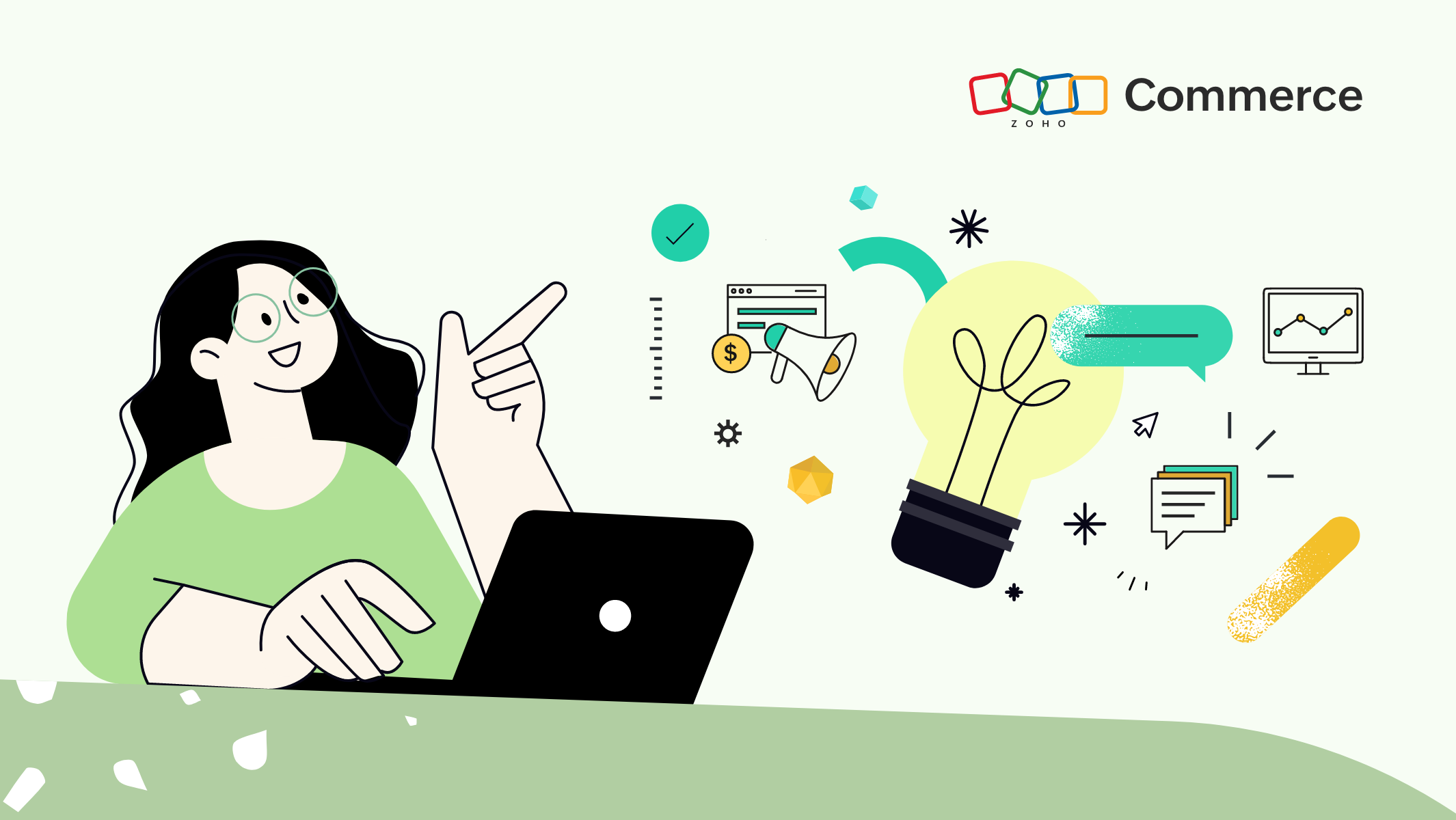Many of us can't get through a day without a to-do list, be it on a piece of paper or in our minds. That's just one person dealing with a day's worth of tasks. What if the list is meant to organize the tasks for an entire business function, like marketing, that's responsible for a company's revenue and reputation? As mind-mindbogglingly tough as it sounds, it need not be with a sound marketing strategy.
What is marketing strategy?
Marketing strategy is this comprehensive to-do list that details the marketing game plan for a business. It defines your niche audience and the different tactics that can be employed at different stages of marketing to get them to listen to you. It is your action plan to get leads, nurture them, and convert them into loyal customers. A good strategy will give your marketing initiatives a sense of direction and purpose which will be aligned with your business goals.
So, why do you need a marketing strategy?
Without one, an entrepreneur is on a wild goose chase to pursue customers, profits, and growth. Putting your business plan into action without a marketing strategy can bleed you of money and jeopardize your company's survival. No matter where you sell, online or offline, you should have a strategy especially if you are an entrepreneur. The strategy helps organize the company's resources and bands them together to achieve stratospheric advancement. You are more likely to succeed in comparison to your peers when you have a marketing strategy in place.
Defining a marketing strategy for your online business
If you are an ecommerce company, you have tons of competition to fight against to make yourself known, accepted, and (if you are fortunate enough) loved. A robust marketing strategy will you get there. There are some cardinal rules you must bear in mind when you are building your marketing strategy.
Step 1: Identify the problem your product is solving
What is the problem your product is trying to resolve? Check if your product is addressing something underserved in the market. Interview prospects and users of similar products you plan on selling. Do not just identify the problem, but get to the bottom of it. For instance, try to understand why supermarkets require sturdy grocery bags. Do they want stronger straps, waterproof bags, or a broad and stiff base to hold weight? Look into how the existing products are unable to meet specific demands of the users. Find out how urgently the consumers want their problem solved and, most importantly, if they are willing to shell out extra bucks to get the solution.
Step 2: Determine your ecommerce target audience
Having products to sell is great but you also have to be certain to whom you want to sell them. Start by collecting data about the age group of the usual shoppers. If you do not understand your prospects and what they appreciate, you will lack the clarity required to garner their attention, and will not be able to communicate with them. They have to be segmented and addressed separately. You can't use the same messaging tone or language on a baby boomer, millennial, and Gen Z (imagine the number of people you will be offending). Find out what your buyers do, their problems and challenges, their emotional triggers, and the way to build their trust. Creating user/buyer personas will bring you a step closer to understanding your customer.
Use: Readily available buyer persona templates on websites like Selling Signals, Iterative Marketing, and HubSpot.
Step 3: Get to know your competitors
Research your competitors and their products. Use them, and find out why people love or hate them. See how they are packaged, labeled, and priced. Try to understand their market positioning. Check their website, social media content, videos, webinars, blogs, and testimonials. Sign up for their newsletter and screenshot their ads. Analyze how they talk to their audience, the tone, inflection, words, imagery, colors, hashtags, and every other detail. When you understand their strengths and weaknesses, you will learn to articulate yours better and know how to stand out to the audience whose attention your competitors are vying for.
Use: Tools like Semrush and Similarweb let you check how your competitors fare in search rankings and web traffic. You can do a comparative analysis before that using templates on Atlassian and Smartsheet.
Step 4: Decide on your marketing channels
Choosing the right digital marketing channels will amplify the reach of your ecommerce business. Remember, the channels you decide upon aren't set in stone; you can change them to ensure the success of your marketing initiatives. Depending on your primary marketing goals (brand awareness, lead generation, customer acquisition, customer retention, or others), the audience you are targeting, your budget, and your competitors, choose the most effective marketing channel to create an impact on your audience. For instance, if brand awareness is your goal, you will have to focus on SEO initiatives, PPC advertising, SMS marketing, social media (organic and paid), and content marketing (top-funnel content like blog posts, articles, FAQs, listicles, podcasts, videos, etc.).
On a related note, remember that two kinds of marketing will impact your choice of channels. When you pay money to digital and social platforms to access their audience and their clicks, you are using paid marketing. Organic marketing is the opposite of it. That is a method that does not require you to pay to get traffic to your website.
Use: Read the guide to understand the various channels an ecommerce marketer can utilize. The information on the marketing funnel in the section below will also help you decide on the best marketing channels.
Step 5: Estimate budget requirements
If you are a business that's just venturing into the dotcom world, you can't easily loosen the purse strings, especially for marketing. According to Jessica Horvath, a business advisor at the Business Development Bank of Canada, the common rule of thumb is that B2C companies must spend 5 to 10% of their revenue on marketing. Whereas, B2B companies usually allocate around 7.8% of their revenue to marketing. Adhering to budgets and choosing the best options will help you grow and prevent misspending on marketing. As your online business grows, you can check the ROI of campaigns, the effectiveness of marketing channels, and other metrics, then readjust your budget allocation.
Use: Budget calculators on platforms like Upwork, HubSpot, WebFX, and Brillea.
The strategy you build must address consumers throughout their buying journey, which is often visualized in the form of a funnel by online marketers. A strategy failing to add value to this funnel will lack cohesion and will certainly need revision which is an expensive complication you can avoid at the very beginning. The key to doing this is understanding the marketing funnel.
Building an ecommerce marketing funnel
An ecommerce marketing funnel traces the online journey of your potential customers at every stage and step as they go from website visitors to buyers. A basic way of demonstrating this would be, "Is the customer aware of this brand?" then, "Are they interested?" then, "Are they definitely going to buy?" Without a funnel, your marketing efforts won't give you any rewards.
No matter who your customer is, a virtual window shopper, an interested buyer, or a loyal brand advocate, a marketing funnel categorizes them in a way that will help marketers communicate with them more effectively. For instance, you can't invite a first-time shopper to join your referral program or give a paltry discount to your long-time customer because it is not the incentive they are looking for. Design a plan that will make buyers aware of the brand, allow you to engage with them through various mediums, and then spur them into taking a purchase decision.
As an online entrepreneur, your first step must be to spread awareness about your brand and bring visitors to your ecommerce website, which is at the top of your marketing funnel. At this point, they might be merely browsing. You need to establish the credibility of your brand and offering. Only then will a handful of customers with an actual interest in your products move to the next stage, the middle of your funnel. From there, even fewer visitors move to the bottom of the funnel, after perusing countless reviews, articles, and alternatives. Marketers call this the TOFU-MOFU-BOFU model.
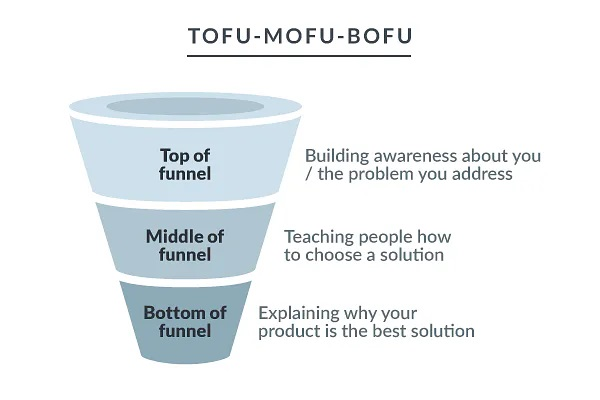
Source: Customer Devoted
You will need to plan a sequence of communication prompting consumers to take appropriate action according to each stage of the funnel. If you can't conceptualize this funnel, optimizing different touchpoints of the funnel will be a challenge.
The visual representation of a customer's steps before their purchase can be defined in another manner popularly known as the AIDA framework.
Basic pipeline anatomy - the AIDA model
Decades back, Elias St. Elmo Lewis propounded a seemingly simple structure that analyzes a customer's buying journey, now widely known as AIDA (Attention, Interest, Desire, and Action) model. Some models use awareness and attention interchangeably when they expand the "A" of the model. Nevertheless, this structure caught the attention of marketers who firmly hold the opinion that external stimuli are what lead to a favorable response from their target audience.
The funnel can look a tad different for B2B and B2C businesses.
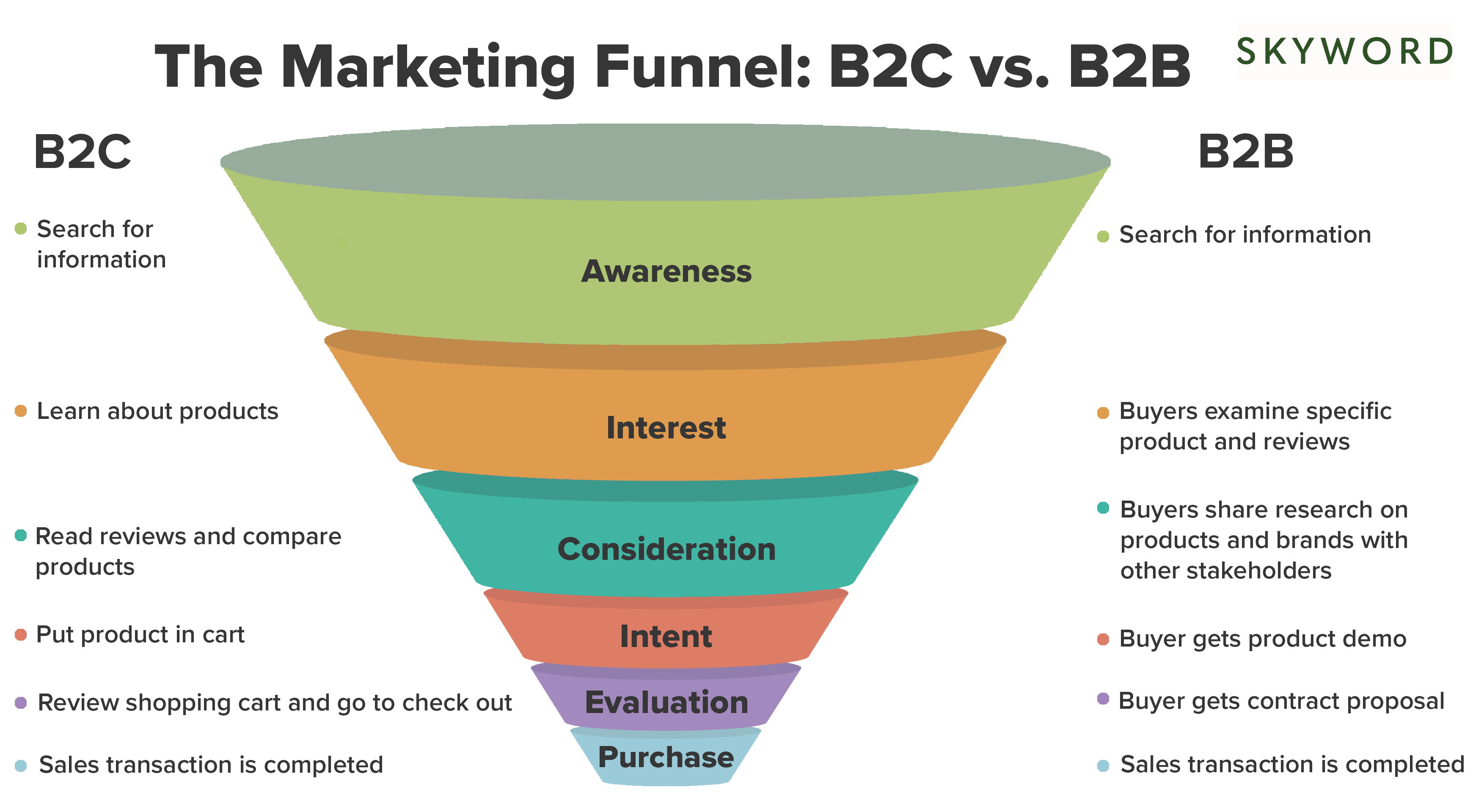
Source: Skyword
Let's dive into the AIDA framework.
Awareness
Think of this as another term for the top of the funnel. Your customer realizes they need or want something. They know what they need but they are not confident about what exactly to buy or where to buy it. This is the awareness stage, where customers are aware they need to make a purchase. They may have seen their favorite Instagrammer post something with tags, "#ad" or "collab" or "#paid partnership," piquing their curiosity. Or, they might have simply searched for a solution on Google.
If you happen to have a strong marketing plan, your customer might stumble upon your brand on Google, Instagram, or any other online channels. For you, this is the lead generation phase where you try to collect the information of your customers and classify them so they can be guided further down the funnel.
Goal: Make a great first impression and draw them into your ecommerce site. Work towards creating brand awareness and generating leads.
Marketing devices
Organic:
SEO initiatives - Intertwined with the rest of your marketing efforts, SEO practices are blended into content creation, social media, website pages, etc. This is particularly useful for the awareness stage where customers who still don't know about your brand need to discover it.
Social media (organic) - You are what your social media is. Do not shy away from utilizing all platforms, including question-and-answer ones like Quora or Reddit, which may be an excellent TOFU/Awareness medium. Make a great first impression at this stage.
- Content marketing - Your top funnel content, aimed at first-time website visitors, needs to be informative and engaging. Write short articles, and create interesting podcasts and videos disseminating knowledge and advice. Even a B2C sports brand like Nike runs a podcast to discuss nutrition, sleep, and other facets of health. Focus on informational keywords (words that people type into search engines to seek information or answer their query) to start ranking well on search engine results pages.
Paid:
Paid ads - Pay search engines, social media, and websites to get online ad space and customers' attention. It's a great way to increase traffic, but make sure you don't attract the wrong audience. Check the metrics and fine-tune your campaigns regularly. Pay-per-click (PPC) ads, text ads, responsive display ads, video ads, product shopping ads, and social media are some examples of paid ads.
Social media (paid) - An extension of the previous point, you can choose to connect with your audience on Facebook, Instagram, Snapchat, Twitter, LinkedIn, and other social media platforms. Experiment with carousel ads, single-image ads, text ads, and more.
Influencer marketing - Tap into the popularity and existing fan base of influencers to create brand awareness. Find out your goals, scout for the right influencer whose work resonates with the brand, and check for their follower count, engagement, reach and specialization before you collaborate with an influencer.
Affiliate marketing - Use the influence and popularity of an affiliate member who'll promote your products on their channels via blogs, videos, emails, or ads. Traffic via affiliate marketers can be pretty useful as they might be your exact target audience who are in search of solutions/products that you have to offer. This can prove beneficial in the awareness stage.
How to measure ROI: Check your organic traffic, direct traffic, impressions (number of times your ad renders on users' screens), and increase in social media followers and social engagement.
Interest
Once the consumer discovers your brand, they will want to know more. They will make their way to the middle of your marketing funnel. By now, they are a lot more confident about what they want, because they have recognized their pain point. That means they now know the benefits they are particularly looking for from a product they wish to buy. During the interest stage, as a brand, you try to grab the shopper's attention and keep them hooked to your brand.
We mentioned lead generation in the previous stage, where you collect information about your audience. At this stage, you can put that information to good use by contacting them via phone, email, or through social media to ensure they do not slip out of the funnel. You need to nurture your warm leads. If they were on your ecommerce website, this could be the stage where they add products to their wish list.
Goal: Your marketing communication should address all the "pain points" or requirements of a consumer. Work towards prolonging their interest and building trust.
Marketing devices
Organic:
Homepage - Your homepage must load quickly on all devices; have smooth navigation; mention important offers and announcements; list your bestsellers and new arrivals; have chat widgets, CTAs, and pop-ups; and include a sign-up form. Online shoppers trust a well-designed website that lays out the information they are looking for (or leads them to it) clearly. At this stage, trust is precisely what you need to establish.
Product pages - Charm your customers with a good product page. Have a detailed description, features, reviews, estimated delivery dates, and similar useful information. Use four to five good images (with zoom-in features) showing all necessary angles of the product, and include a video if possible. All media must load quickly.
Product descriptions - Make sure your product description on your product page matches the tone of your brand. Make it quirky if you're describing a superhero collectible, stylish and sophisticated for haute couture, or informative and interesting if it's a gadget. Write descriptions that are unique and will leave the shopper wanting to buy it right away.
Content marketing - Draft mid-funnel content, like detailed informative articles and blogs, industry-specific Q&As with subject experts, lookbooks, how-to tutorials, or other attractive videos (make-up brands often include them on product pages to showcase makeup applications, like Rihanna's Fenty Beauty).The content must be either persuasive or authoritative in tone to get your customers hooked to your website and also convince them that you are a subject expert (and that you really know what you are doing and selling).
Emails - Tailor beautiful emails targeting your audience with the right message. Put together stats, stunning images, or heartwarming messages depending on the products you sell, your audience, and the occasion. Don't forget those CTAs and buttons to take them to your page.
Chat support - Incorporate a chatbot to answer frequently asked questions. Chatbots can also be used to guide the shopper to purchase. They can prompt shoppers with questions about what they are looking for, their desired price range, and other things to help push a sale. If needed, a chatbot can push the potential buyer to a customer service professional who can help and create an emotional bond (something that will be particularly useful in the next step).
Paid:
Paid content upgrade - See if you can get your customers to pay to access premium content like in-depth research papers, market reports, and other select content. You can also introduce masterclasses or other online courses for a small fee. Paid sign-ups could act as a good indication of the trust they place in you as a subject matter authority.
Paid ads - In this stage, too, paid ads can help you reach your targeted segment of the audience. From Google Ads to other ad platforms, you can choose to bid and focus on high-intent keywords to grab your buyers' attention.
How to measure ROI: Check the average time visitors spend on your page (if it's higher, they might be interested in buying or learning more about you). You should also check your bounce rate (percentage of people who exit after viewing just one page without taking any action). An optimal bounce rate falls between 26% and 40%. Email open rates (average email open rate is 21.33%) can also help measure your ROI.
Desire
By now, the consumer has traveled a long way since they first thought of buying something online. This is the stage where the customer becomes emotionally absorbed in the idea of purchasing a product. They don't just need it or like it, but they want it. The customer pictures using the products and reaping their benefits. For instance, a trekker browsing a camping website starts to imagine how amazing their next trip is going to be with a lightweight, portable barbecue grill. They might even add it to their cart. They are an inch away from clicking that checkout button. The only thing stopping them is the knowledge of alternative options. Unless you have created an emotional bond with your customer, their attention will waver.
Goal: Concentrate on conversion-focused marketing efforts that will help customers overcome doubts or fear about the purchase. Display your brand's unique selling proposition, which sets you apart from (and above) the competition. There needs to be compelling communication proving why you are better than your competition (price, features, or aftercare). Clear shipping and exchange policies and other terms will help your customers move to the next and final stage of the journey.
Marketing devices
Organic:
Social proof - Your prospective buyers will look for social proof that yours is a legitimate brand selling authentic products with satisfied and happy customers. That comes in the form of user-generated content (UGC) which includes online reviews and testimonials and social media tags, comments, stories, reels, and exciting unboxing videos. Build your presence on Yelp, Trustpilot, Google (reviews), Tripadvisor, G2, Capterra, and any other relevant review sites.
Content - Dish out effective bottom-funnel content that convinces your customers to make the big decision. Examples of content at this stage can be comparison articles, case studies, customer testimonial videos, comprehensive FAQs, and downloadable content like product comparison tables, whitepapers, eBooks, detailed guides, and on-demand webinars. Competitive analysis reports, analyst reports, and PR news articles can also present convincing arguments in your favor at this stage.
Pop-ups - Introduce pop-ups to announce coupon codes, slashed prices, time-sensitive offers (like a discount expiring within an hour or so), free shipping promotions, and other tempting offers to prevent them from exiting the funnel. Add exit-intent pop-ups which will help you understand why your customer is leaving the page without making a purchase.
Email - If a website visitor leaves without making a purchase, send them a series of well-thought-out abandoned cart emails. Remind them in various ways what they are missing out by not buying the product in question.
Free demos and trials - If you are a B2B SaaS company, free demos and trials are important ways to win over your customers. Once the customer gets acquainted with the software, they are fairly comfortable with the idea of purchasing it.
Paid:
Retargeting ads - Studies show 97% of website visitors who usually leave without buying can definitely be brought back to the funnel with the help of retargeting ads. These help you repeatedly appear on their screens, which will entice them to revisit your page, increasing your possibilities of making a sale. Google Ads, Facebook retargeting, and other social media platforms will help you appear on websites that your potential customer is visiting.
How to measure ROI: Check for a weekly or monthly (depending on the business) percentage growth of leads through various marketing sources and campaigns through UTM parameters. Make a note of your cost per acquisition (CPA) which you get by dividing your total campaign cost by the number of customer acquisitions.
Action
Ambling down the funnel, the customer finally reaches the juncture where they are determined to own a particular product from a specific brand. They are ready to buy from you. This is the bottom of your funnel, the decision stage where a prospect turns into a paying customer. This final stage of the ecommerce funnel is complete when the website visitor enters their payment details and finishes the transaction.
Goal: Customer retention and growth must be your primary goals. Action is not just about purchasing and smooth onboarding. It is equally about ensuring proper adoption or usage, cultivating user loyalty by rewarding your customers, and getting their help in building social proof by collecting reviews, feedback, and ratings.
Marketing devices
Organic:
CTA buttons - Your clickable CTA buttons, be it "Buy Now" or "Checkout," should be attractive, placed at convenient points, and function smoothly without glitches. A customer should never click on a button only to discover they are not being redirected to the checkout page.
Checkout process - Design a checkout page that is neat and has only relevant fields. Known deterrents could be limited payment options, a lengthy and complicated checkout process, lack of guest checkouts (you can encourage them to create their account but not force them), page crashes, and additional charges in the form of taxes or shipping (a 2022 study revealed 48% abandon their cart for this reason).
After sales support - Your post-purchase service has the potential to turn your buyers into repeat customers and then brand advocates. You can start with emails acknowledging payment and order status along with a nicely worded thank you note. That apart, fast and safe delivery, good packaging, easy returns, great customer support, installation guides or product usage directions (if any), and easy refund initiation are some ways to ensure you provide a great post-purchase service. You can also shoot emails with forms to get feedback or include links for them to submit reviews or ratings. Do not shy away from cross-selling or upselling based on a customer's purchase history.
Rewards and promotions - An effective way of building loyalty includes rewarding your regulars with special incentives. Think of point-based loyalty programs, early access sales, sneak peeks of new launches, and exclusive offers for only subscribers. Send emails about intimate time-sensitive offers like a birthday or anniversary coupon (with a heartfelt wish, of course) or present coupon codes for other occasions. Invite them to be a part of your referral programs. It will bring you more customers and also reward the customer with points and discounts for referrals, along with the intangible feeling of being important and counted.
How to measure ROI: Keep track of customer churn (if you are a B2B company) percentages or the percentage of old customers making a secondary purchase within a specific time frame (if you are a B2C company). Analyze conversion rates per channel (divide the total number of conversions by total number of sessions and multiply that by 100) to determine the ones that have been profitable to you. Look into customer lifetime value (CLTV) which looks at the revenue a customer is likely to generate until the time they remain customers with us (which could be for years). You can use simple steps to calculate CLTV.
The infographic below summarizes ecommerce marketing funnel and the various paid and organic marketing channels to be used in each stage of the funnel.
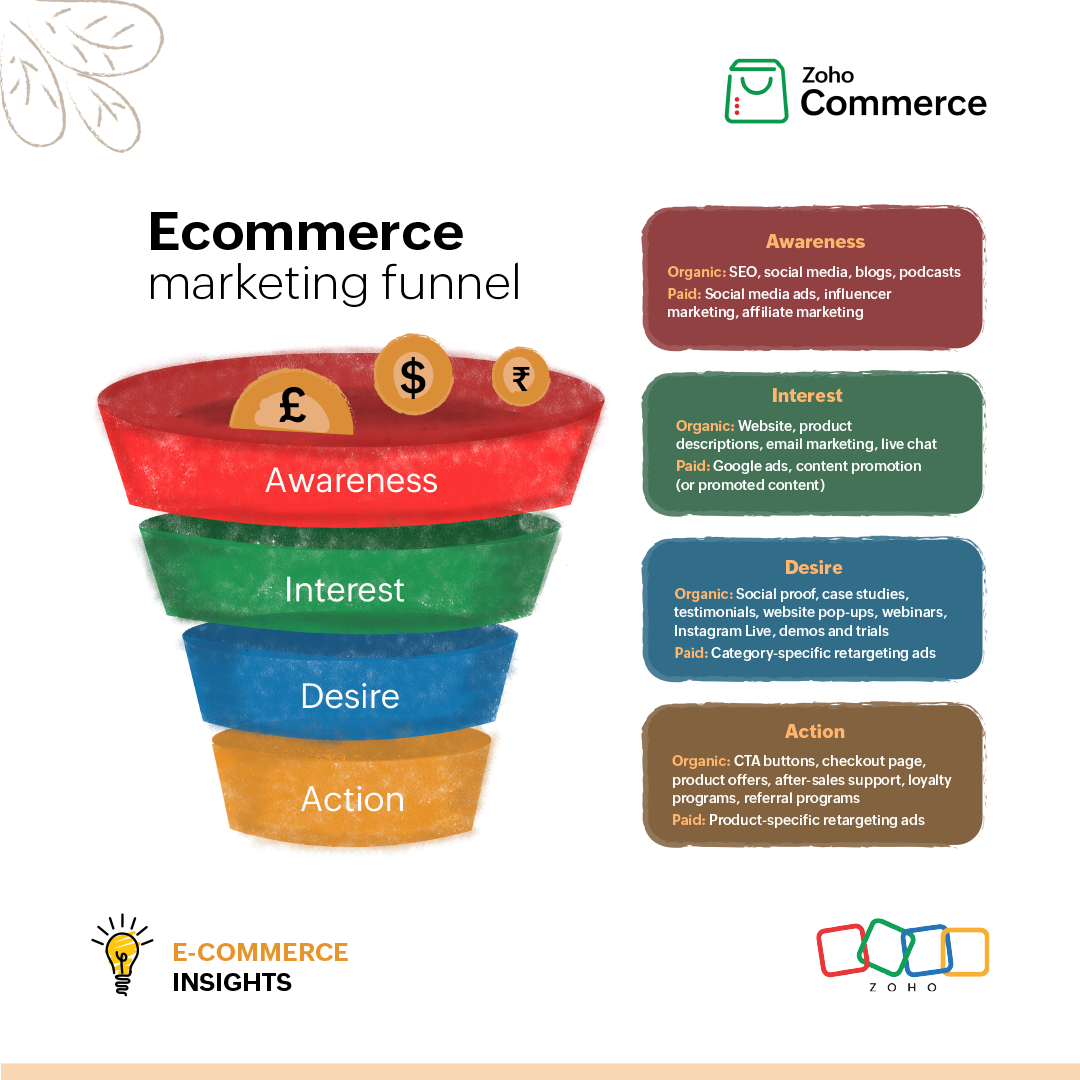
This brings us to the end of the funnel. AIDA defines the way a person progresses from being a window shopper to becoming a buyer and a loyal customer. This helps ecommerce marketers understand what promotes favorable action in customers.
However, there are detractors of the century-old model. Some feel that sales processes and customer behaviors have evolved and so should the model. Some argue that it doesn't take into account non-linear models where customers go back and forth over mediums and decisions. While these valid concerns do exist, most marketers agree that AIDA is a broad and reliable framework that can be developed upon, split into more stages, and reused suitably. The very fact that more than 100 years later, online articles do not talk about marketing without mentioning the AIDA framework says something.
Before concluding, we would like to leave you with a couple of examples.
B2B marketing strategy example
As a B2B organization that's just starting out, visibility must be your top priority. Pump in a large percentage of your marketing budget into top funnel marketing (or awareness) campaigns. Use paid ads, including social media ads, to get clicks and traffic. Target the right demographics based on their interests, qualifications, and more. Keep your social media profiles active, especially on B2B social media platforms like LinkedIn, YouTube, Twitter, and Facebook (or even Instagram or Snapchat, if your audience is there).
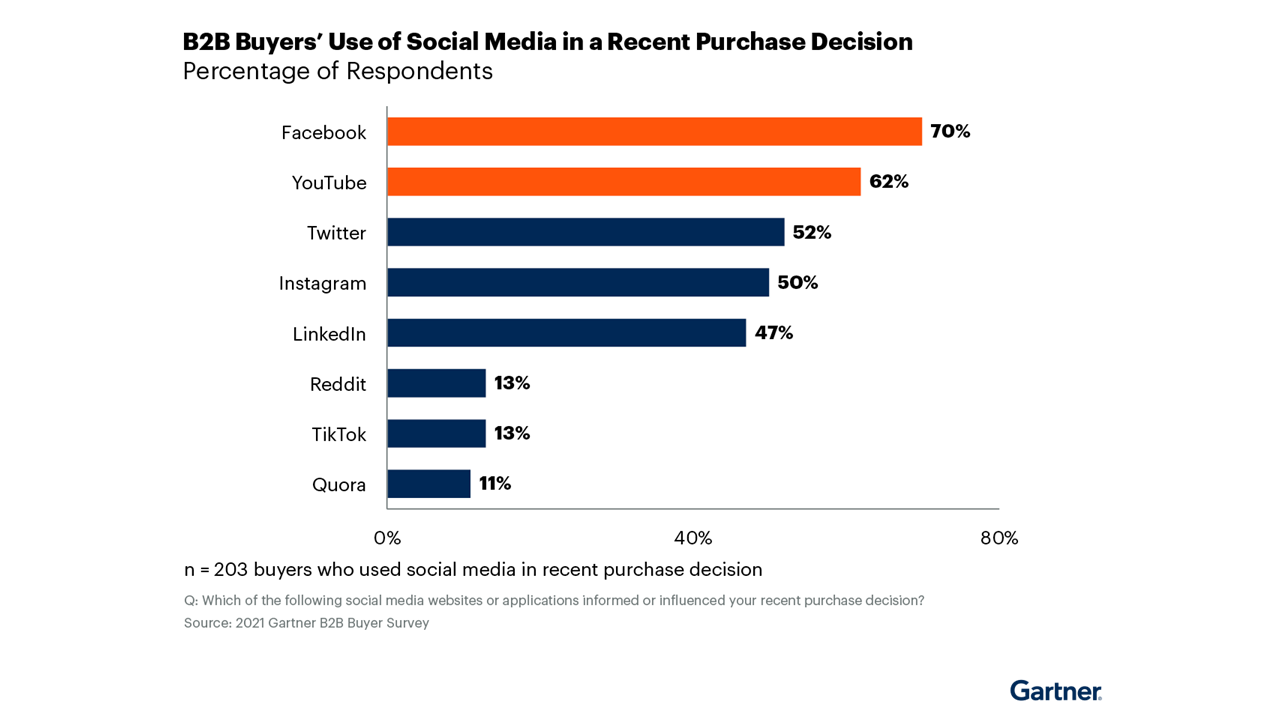
Source: Gartner
Create interesting infographics, downloadable brochures, blogs, and videos and optimize them to rank high on SERPs (search engine results page). Get visitors to your page.
The next step is for you to design a landing page that serves your customers information on a platter. Ensure there are enough CTAs on your page and that the customer never leaves without filling out a form sharing their basic information. Following this, you can try drip marketing to send tailored emails to your customer, sharing apt information (advantages of using a product, monetary gains, business improvement, revenue growth, etc.) that particularly addresses their pain points. Video tutorials and webinars can prove helpful, too. Be sure to share informative, industry-relevant information.
Once the customer is on the brink of a decision (the Desire stage of AIDA), you can send communications about offers, free demos, and trials. Share product comparison tables or brochures, customer case studies and testimonials, whitepapers, and snapshots of analyst reports to establish the superiority of your offering. Bottom funnel communication is not expensive but creates high impact. Whatever you share nudges them into making the big decision to choose your product. In the last stage, they become your customer. You'll have to ensure you send out email assurances, that a smooth purchase transaction takes place, post-purchase emails are sent out, and help documents and guides are shared. Help them use or adapt your product, and collect feedback and references.
B2C marketing strategy example
B2C brands need to navigate through industry crowd and clutter to be noticed. The competition is intense. Akin to a B2B marketing strategy, start by dedicating a large share of your marketing expenses towards getting noticed. Google Ads and social media ads are a great way to begin. If you have the budget, you can try influencer marketing, too. You can start with nano (1-10k followers) and micro (10-100k followers) influencers. Affiliate marketing can be an excellent option for B2C marketers, too.
On the organic marketing front, use your social media handles to the hilt and explore platforms like Snapchat, TikTok, and Reddit. Content like short articles, podcasts, and videos can also spark interest. Connect authentically with content that resonates with buyers' likes and interests (against something that is just a product plug). B2C communication must trigger emotions, which is why you sell the sizzle and not the steak. You're not just selling a product, but a feeling and an experience.
Make your homepage do all the work once they land there by featuring a slick UI and amazing layouts and designs optimized for all devices (a lot of B2C transactions happen on phone). Create great product pages with enticing product descriptions and clear product feature information. Put together FAQs, lookbooks, blogs, and similar content optimized for SEO, with searcher intent in mind (what the buyer wants the Internet to answer them). SMS or email marketing can be utilized as well. B2C consumers look for reviews and star ratings, which should be easily available to them, if you put in work toward building social proof.
Once they are convinced, encourage them to sign up and make a purchase. Even if they slip out out the funnel, continue to charm them with special offers or abandoned cart emails, or retargeting ads, so they never forget you. Your job as a B2C marketer doesn't end there. Follow up with great post-purchase communication in the form of order emails, delivery tracker emails, feedback and review emails, and similar outreach. Tempt them with related products or loyalty programs and invite them to join your referral programs. Design repurchase or replenishment flows to make sure they are hooked to your brand and, over time, turn into brand loyalists.
In summary
We hope this helped you understand more about ecommerce marketing strategies, the five steps to build one, the ecommerce marketing funnel model, and the AIDA marketing mode along with suitable marketing channels, and the examples of B2B and B2C marketing strategy.
We're happy to help you navigate the tricky waters of ecommerce marketing and ace the marketing game. If you'd like further help you with ecommerce or marketing, drop an email to marketing@zohocommerce.com.

